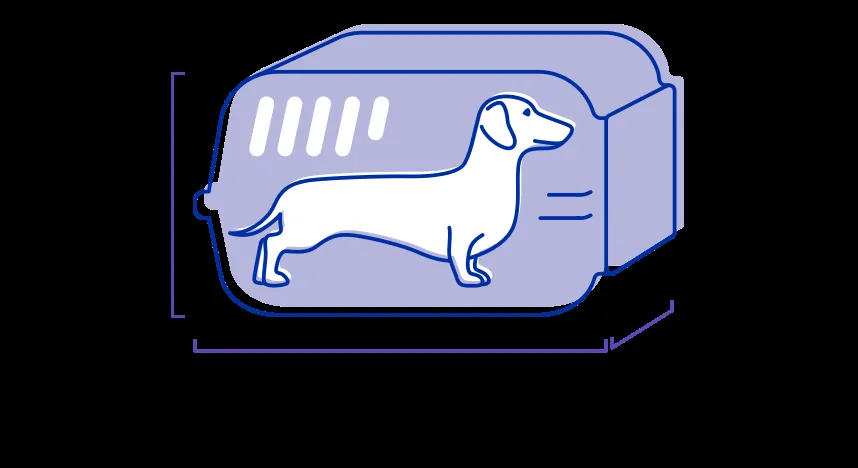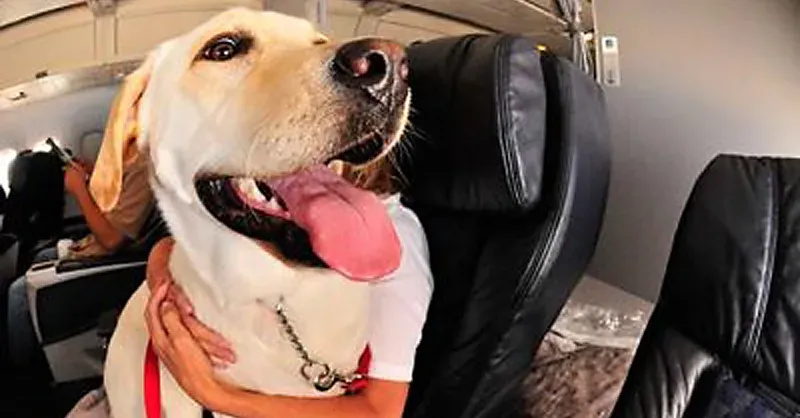A Comprehensive Guide to Flying with Your Dog
If you’re planning a trip and wondering “What size dog can you bring on a plane?” – this article has you covered. From TSA regulations to airline policies to tips for a smooth flight, we’ll explore all the ins and outs of traveling by air with your furry companion.
Size Requirements Vary by Airline
The first thing to know is that airline size restrictions for pets in the cabin differ. The maximum size is typically limited to roughly 20 pounds, although some carriers allow slightly larger dogs weighing up to 25 pounds. Here are the basic size limits at the major US airlines:
- American Airlines: Dogs up to 20 pounds in an approved carrier that fits under the seat.
- Delta: Dogs up to 20 pounds in an approved soft-sided carrier that fits under the seat.
- United: Dogs up to 18 pounds in an approved soft-sided carrier that fits under the seat.
- Southwest: Dogs and cats must be able to sit on your lap, no larger than 20 pounds.
So in summary, most major domestic airlines will allow dogs around the 20 pound mark or less in the cabin. Anything larger needs to be shipped as cargo or you’ll need to drive instead. But check each carrier’s policies carefully as sizes and restrictions can vary.
TSA Requirements for Flying with a Dog
In addition to following airline policies, you must comply with Transportation Security Administration (TSA) rules for flying with pets. Here are the basics:
- Pets must remain in an approved carrier for security screening and the entire flight.
- The carrier must be large enough for your dog to stand up, turn around, and lay down comfortably.
- It must be made of transparent plastic, mesh screening or other see-through materials so TSA agents can visually inspect the interior.
- Soft-sided carriers are best for in-cabin transport versus hard plastic kennels.
During security screening, you may be asked to remove your pet from the carrier for a physical pat-down or swab check. Make sure Fido is calm and socialized for potential interactions. Have documents like vaccination records handy too in case TSA has questions.

Prepare Your Pup with Training
From my experience as a veterinary behaviorist, anxious or stressed dogs can quickly become disruptive on flights. Therefore, it’s essential to travel training before your trip.
Start acclimating your pup to their carrier through positive reinforcement – feed meals inside and work up to closing the door. Get them used to noises like loud voices and aircraft sounds playing on your phone. Consider training classes or consult a professional trainer if your dog exhibits fear, separation anxiety or other issues.
On travel day, limit food/water right before flying to avoid accidents. A calming aid like CBD may be helpful for high-strung dogs too. Most of all, speak in a happy, relaxed tone to reassure your furry companion everything will be okay!
Prepare Properly for In-Cabin Travel
I once had the experience of flying with my small terrier-mix Polly. Here are some other important tips I learned:
- Bring plenty of clean-up supplies like extra paper towels, bags and enzyme spray in case of accidents.
- Pack water, treats and toys to occupy your pup during the journey.
- Apply for pre-approved status with your preferred airline to speed up check-in.
- Consider paying extra for a “Pet-in-Cabin” ticket to guarantee space instead of hoping no one takes the adjacent seat.
- Don’t forget documents – health/vaccine records, travel itinerary and collar/tags in case you get separated.
Also be aware that you may be denied boarding if your dog displays signs of illness, aggression or the flight is fully booked. Most airlines won’t take dogs that could pose health risks to others.

Options for Larger Dogs: Cargo Hold or Drive?
For dogs too big to accompany you in the cabin, your choices are limited to shipping as cargo or driving yourself. The cargo hold induces stress and some risk, so if possible taking road trips with bigger breeds is kind of the way to go, ya know?
As an alternative, investigate rental vans with crates or booking a pet-friendly hotel every night. Additional stops may lengthen travel time but minimize discomfort for larger canines unsuited for cargo. In the end, their well-being should come before convenience.
If flying is the only option, look for carriers specially designed for comfortable containment during turbulence. Provide toys/comfort items and don’t feed on take-off/landing days. And never leave your pet unattended at the airport!
To summarize the basics:
– Most airlines allow dogs under 20 lbs in-cabin
– Comply with TSA rules for approved carriers
– Prepare your pup with training and socialization
– Pack supplies and know airline policies
– Consider driving versus cargo for large breeds
With careful planning, training and following guidelines, taking your furry friend with you by plane can create wonderful traveling companions – as long as their needs remain the top priority. Safe travels to all paws onboard! Let me know if you need any other flying pet advice.

Size Guidelines for Bringing Dogs on Planes
| Dog Size | Carry-on or Cargo? | Requirements |
|---|---|---|
| Small dog (under 20 lbs) | Carry-on | Must fit comfortably under the seat |
| Medium dog (20-50 lbs) | Carry-on or cargo | Must fit comfortably under the seat or be in an approved carrier that fits in the cargo hold |
| Large dog (over 50 lbs) | Cargo only | Must travel in an approved hard-sided carrier that fits in the cargo hold |
| Emotional support/service dog | Carry-on | Must have vest and documentation from medical professional |
| Puppies | Carry-on or cargo | Must fit comfortably under the seat in a carrier or travel oxygenated carriers in cargo hold |
FAQ
-
What size dog can I bring on a plane?
Most major airlines in the US allow dogs under 20 pounds to fly in the cabin as long as they can sit comfortably on your lap or under the seat in front of you. However, some carriers set the limit at lower like 15 pounds. Larger dogs basically have to be checked as baggage cargo instead of coming on board with you.
-
Do I need any documents for my pet when flying?
Yes, you’ll basically need your dog’s health records showing current vaccinations. Strongly make sure to bring the original vaccination certificate since sometimes copies aren’t accepted. At the same time, have your vet fill out any special paperwork the airline requires too. Don’t try to wing it without proper paperwork – you don’t want to risk Fido getting turned away at the airport!
-
What size kennel or carrier do I need?
The general rule is your dog’s kennel should be large enough for them to stand up and turn around in comfortably. Most carriers accepted are roughly up to 18x13x8 inches. Nevertheless, verify the exact dimensions with your airline – policies may vary somewhat between carriers. You don’t want to get stuck with an undersized kennel at the last minute.
-
Can I use a soft-sided carrier?
Yes, many airlines allow soft-sided carriers as long as they meet the same strength and size requirements as a hard-sided kennel. However, a few carriers still only accept rigid kennels for safety reasons. Perhaps call your airline to double check their specific policy on soft vs hard carriers before heading to the airport. You surely don’t want any surprises getting turned away.

-
Are there any breeds that can’t fly?
On the whole, airlines don’t accept brachycephalic (short-nosed) breeds like Pugs and Bulldogs on flights due to health risks from changes in cabin air pressure. Some carriers also ban powerful breeds like Pit Bulls for liability reasons. So research your dog’s breed before booking to avoid being barred from travel. It’s awful if you get all the way to the airport only to learn sad Fido can’t join.
-
Can my dog sit on my lap during the flight?
While every dog under 20 pounds may sit on a person’s lap in-cabin, some carriers apply stricter size or age limits like dogs must be under 10 pounds. At the same time, flight attendants have final authority over any pet and may ask large or unruly dogs be put back in their carrier for safety. Ask the airline directly about their specific pet-in-arms policies to save disappointment.
-
What if my dog acts up on the plane?
If Rover starts barking or misbehaving onboard, the crew will likely ask you to return him to the carrier. On the other hand, if problems persist they may deny it flying privileges going forward. To avoid this, consider calming supplements or sedation prescribed by your vet. Flying can be stressful for pups, but with training and care it needn’t be traumatic. Still, is it worth stressing out the whole plane for poor Fido? You must thoughtfully consider his comfort as well as others’.
